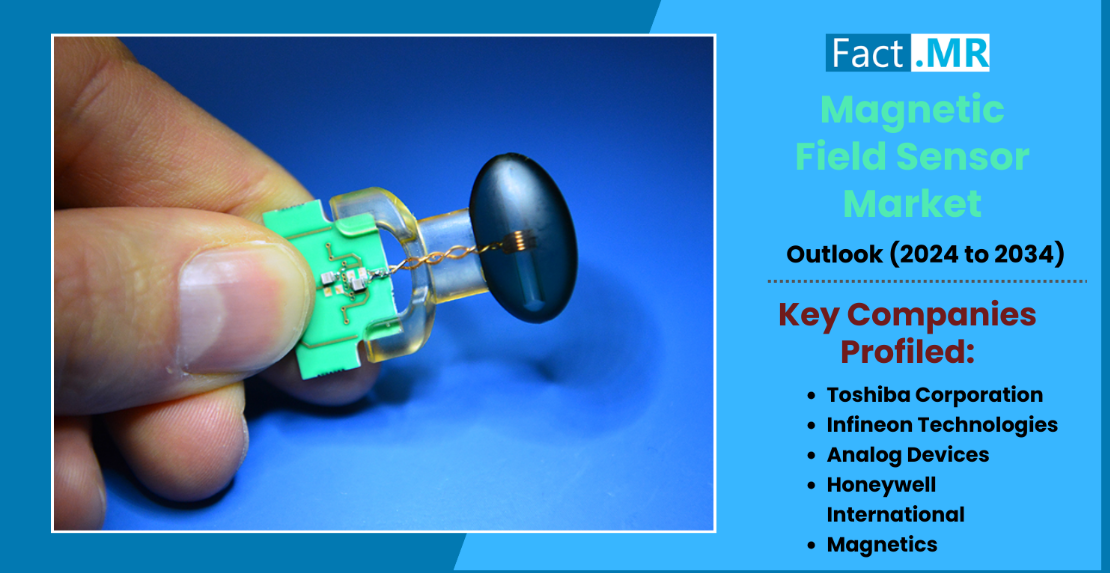Magnetic field sensor market poised to reach $12.2 billion by 2034

Press Release, 6 February 2025
According to a new industry research report published by Fact.MR, a market research and competitive intelligence provider, the global magnetic field sensor market is analyzed to reach a worth of US$ 5.82 billion in 2024 and further expand at a noteworthy CAGR of 7.7% between 2024 and 2034.
Magnetic field sensors are becoming more necessary as advanced driver assistance systems (ADAS), anti-lock braking systems (ABS), and electric power steering are integrated more into vehicles. Their function, which includes sensing location measurement, current, speed, and other factors, is crucial to the precise operation of vehicles.
The market for magnetic field sensors is expanding due to the increasing use of electric vehicles (EVs) and the constant advancements in autonomous driving technologies, which enable vital features, such as battery monitoring, motor control, navigation systems, and more. The automotive sector is becoming a prominent player in market expansion, following the consumer electronics sector industrialization, increasing electronics manufacturing, and growing vehicle production. The market in this region is showing bullish sentiments due to growing demand for electric vehicles in countries as well as the region’s growing focus on smart devices and industrial automation.
Key Takeaways from Market Study
The worldwide market for magnetic field sensors is projected to reach a size of US$ 12.2 billion by the end of 2034.The East Asian region is estimated to hold 32.5% of the global market share in 2024.
The market in Japan is approximated to increase at 8.8% CAGR between 2024 and 2034. By 2034, the market in China is forecasted to achieve a valuation of US$ 2.94 billion. Based on type, sales of hall effect sensors are evaluated to reach US$ 3.67 billion by the end of 2034.
Revenue from magnetic field sensors in North America is projected to reach US$ 3.39 billion by the end of 2034. In North America, the market in the United States is estimated to account for 70.2% market share in 2024.
“Leading magnetic field sensor manufacturing companies are spending money on R&D initiatives to provide high-end products that are more sensitive, accurate, and long-lasting,” says a Fact.MR analyst
High Preference for Hall Effect Sensors in Several Industries
Compared to other magnetic field sensors, hall effect sensors are in high demand because of their adaptability, dependability, and significant range of applications. Hall effect sensors are widely used in several industries, such as automotive, industrial automation, and consumer electronics. Since these sensors detect magnetic fields without direct contact, they are thought to be the best options for tough environments where mechanical wear and tear is a major concern.
Aside from this, hall effect sensors are more precise than several other kinds while also being reasonably priced and compact. Hall effect sensors are preferred over others because of these factors.
Growing Use of ADAS, ABS, and Electric Power Steering in the Automobile Industry
Magnetic field sensors are becoming more and more necessary as advanced driving assistance systems (ADAS), anti-lock braking systems (ABS), and electric power steering become more integrated. According to the prognosis for the magnetic field sensor market, they play a crucial part in the exact or correct functioning of vehicles by detecting various characteristics including speed, current, and position measurement.
The market for magnetic field sensors is expanding due in part to the growing popularity of electric cars (EVs) and the ongoing advancements in autonomous driving technology. They provide vital features including battery monitoring, motor control, GPS systems, and more. The automobile sector is becoming a major advocate for market growth, following the consumer electronics sector.
Issues with Accurate Performance in Tough Environments
Among the harsh conditions that impair magnetic field sensor performance accuracy are high levels of electromagnetic interference (EMI), rising humidity, and extreme temperatures. These elements affect the stability, accuracy, and reliability of sensors, making them less appropriate for crucial applications that need accuracy and durability, such as industrial automation or aerospace systems.
In these industries, where performance in challenging environments is crucial, these limitations are impeding adoption and increasing demand for alternative sensing technologies to guarantee strength and consistency.
Country-specific Perspectives
According to estimates, the East Asia region will account for 32.5% of the global magnetic field sensor market in 2024 and is expected to increase at a stellar 8.2% annual pace over the following ten years. Fast industrialization, the manufacture of electronics, and the expansion of auto manufacturing in nations like China, Japan, and South Korea are all responsible for this increase.
The market is expanding favorably because to China’s growing demand for electric cars as well as the region’s growing focus on smart devices and industrial automation.
Explore More Studies Published by Fact.MR Research:
Smart Grid Sensor Market The worldwide smart grid sensor market is expected to reach US$ 2.39 billion by the end of 2033, growing at a remarkable compound annual growth rate (CAGR) of 15.1% from its 2023 valuation of US$ 587.3 million, according to Fact.MR’s most recent industry study.
IoT Sensor Market According to the newly revised Fact.MR research study, the worldwide IoT sensor market is anticipated to grow to a value of US$33 billion by 2024. By the end of 2034, the market is expected to have grown at a compound annual growth rate (CAGR) of 18.6% to reach a value of US$ 181.7 billion.





